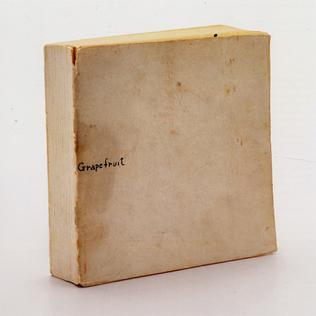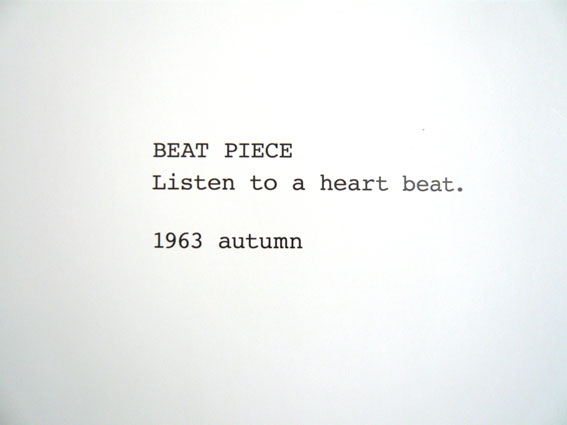An example of her conceptual art includes her book of instructions called Grapefruit. First published in 1964, the book includes surreal, Zen-like instructions that are to be completed in the mind of the reader, for example: "Hide and seek Piece: Hide until everybody goes home. Hide until everybody forgets about you. Hide until everybody dies." An example of heuristic art, Grapefruit was published several times, most widely distributed by Simon and Schuster in 1971, and reprinted by them again in 2000. Many of the scenarios in the book would be enacted as performance pieces throughout Ono's career and have formed the basis for her art exhibitions, including one highly publicized show at the Everson Museum in Syracuse, New York, that was nearly closed when besieged by excited Beatles fans who broke several of the art pieces and flooded the toilets.
http://en.wikipedia.org/wiki/Yoko_Ono
The most famous publication by Yoko Ono: it's a book of her instruction pieces. Originally published in 1964 in Tokyo, Japan as a very limited edition of 500 copies. From 1970 onwards it has been published in several countries and languages. For instance in 1970 it was published in Britain by Peter Owen (hardback) and also in USA by Simon & Schuster (hardback): these books contain approximately 10 new pieces plus letters she'd written to gallery owners and a text of a lecture. In 1971 Grapefruit was published in Britain by Sphere (paperback) and in USA by TouchStone Book (paperback). These later editions contain an introduction by John Lennon and material from the original Japanese 1964 printing as well as later works of art.
One
of the recent interesting international editions of Grapefruit is the bilingual
edition of it by the Swedish publisher and record company Bakhåll. This
edition includes a bonus CD with an exclusive interview given by Yoko Ono on December
15th 2000. The Swedish Grapefruit is basically the same Grapefruit that was published
by Simon & Schuster in 2000 with Yoko Ono's playful intro "Once upon
a thyme, Kind told Keen that she must tell a gory, every naught, to ease his heavy
blind...", but with a different cover. The 11 minute exclusive interview
CD which comes with the book: Yoko Ono explains what conceptual art is, and why
skies are important to her as an artist, etc. All in all, this Swedish publication
is a must for all serious YO collectors, just like the other editions of Grapefruit.
Yoko Ono: "Burn this book after you have read it." John
Lennon: "This is the greatest book I have ever burned." Review from Q, (August
1996): "Early performance pieces collected into book form. Violent and whimsical,
pandemonium of imaginative brilliance to shame all performance artists."
Have some grapefruit!
Somewhere between Zen poetry and a series of instructions for living,
“Grapefruit” is literature as conceptual art, a sheaf of “event scores”
that suggest how to turn daily life into something more engaged.
Imagine the clouds dripping.
Dig a hole in your garden to
put them in.
It appeared on the back cover of Lennon’s 1971 album “Imagine,” and is said to have inspired the title track.
I’ve loved “Grapefruit” from the moment I laid eyes on it, loved its sense of whimsy, its sense of play. The instructions range from the inspirational (“A dream you dream alone may be a dream, but a dream two people dream together is a reality”) to the prosaic (“Step in all the puddles in the city”) to the surreal.
In “Mirror Piece,” written in the spring of 1964, Ono urges:
Instead of obtaining a mirror,
obtain a person.
Look into him.
Use different people.
Old, young, fat, small, etc.
The work here reads like haiku, or even tweets. (There’s a reason Ono is currently a Twitter star.)
What all this has to offer is a way of thinking, of being conscious in the world. The universe is a place of wonder, Ono means to tell us, but we must remind ourselves to look. This is the key to creativity, to being present, which “Grapefruit” insists, begins with every one of us.
Or, as she writes in “Painting for the Wind”:
Cut a hole in a bag filled with seeds
of any kind and place the bag where
there is wind.
David L. Ulin
http://articles.latimes.com/2013/feb/18/entertainment/la-et-jc-happy-80th-birthday-yoko-ono-20130217
Grapefruit is a delightful book of poems and art by Yoko Ono. If you missed this collection when it was published in 1964, now is a good a time as any to take a look. I wasn't even born when this collection first became available, but Ono's book is a classic that ought to be admired and studied by my generation of poets.
Yoko Ono's poetry in Grapefruit is primarily characterized by instructions to the reader. These instructions cannot be taken literally, but instead require the reader to use his/her imagination to perform the commands given. Her technique creates a unique kind of imagery that activates the mind in new way. Ono's commands are more complex than telling the reader to, for example, jump up and down. She uses active verbs to get the reader think about something unexpected. These unexpected images are not characterized by fancy or lyrical language; they are strong, direct and simple.
Some of my favorite poems are the ones in which music is the primary subject, like "Tape Piece I" through "Tape Piece IV." Ono says, in one of the best images from Grapefruit, "Take the sound of stone aging." No one could possibly know exactly what "stone aging" sounds like, but that particular image portrays eternal history. I imagine everything that stone has experienced: all of the sunrises, sunsets, good and bad weather, human life, growth, death, and wisdom developing over time. Ono forces the reader to try to hear something that is traditionally seen. In other words, she gives the reader enough structure to guide his/her thinking while also allowing her words to be highly open to interpretation. Readers can easily impose their understanding of what something sounds like, or what a particular action feels like.
Grapefruit is perfect for people who enjoy collections that are highly stimulating to the senses but can't stand traditional flowery poetry. Ono's metaphors create the same types of imagery without delicate language. Still, her poetry sounds lyrical because of the way in which readers can interpret it. Much can be learned from Yoko Ono's approach to imagery. As a young writer, I admire her distinctive style and will look back to Grapefruit whenever I am sick of fluttering butterflies.
Talia Clay
http://voices.yahoo.com/revisitng-yoko-onos-grapefruit-book-instructions-2521303.html





No comments:
Post a Comment